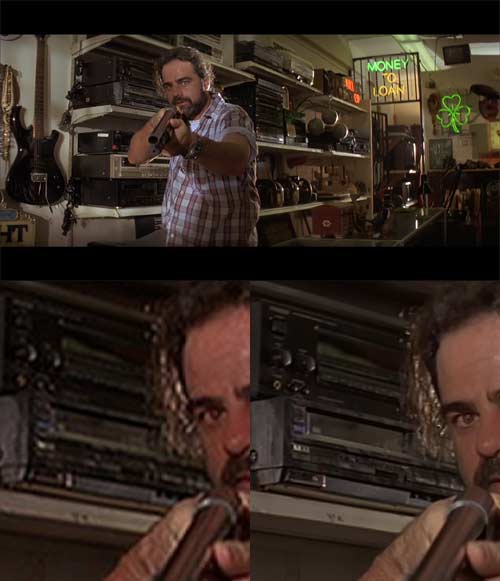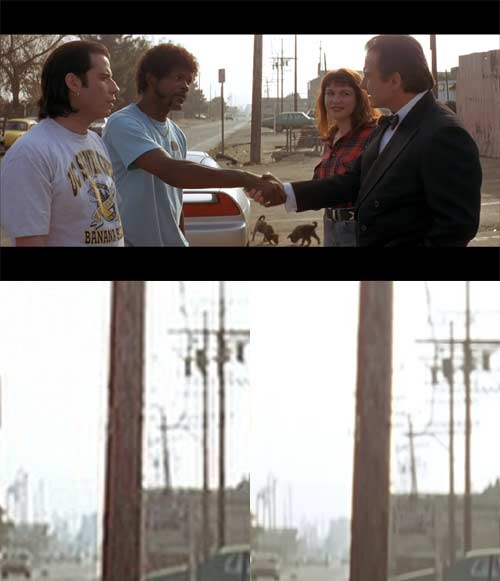 Picture:
Picture:  Sound:
Sound:  Extras:
Extras: 
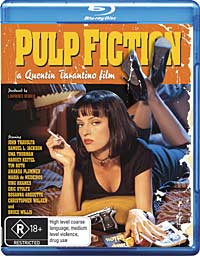
Download scan of review (JPEG, right click, Save As)
Movie:  Picture:
Picture:  Sound:
Sound:  Extras:
Extras: 
Why 'Thank goodness'? Because for more than six years I have been moaning about the quality of the Australian DVD. In fact, I would suggest that for picture quality, it is amongst the half-dozen worst for any recent prominent movie available in Australia on DVD.
Roadshow released three versions of this movie on DVD. The first was so bad, apparently, that a remastered version was released within months. The new release wasn't much good, but apparently a great improvement over the former.
So what was wrong with it?
DVDs have their video stored in interlaced format, that is, broken up into two fields, one with the odd-numbered scan lines and the other with even-numbered scan lines. If the DVD came from a progressive source -- such as film -- then all that the display has to do to recreate the original frame is stitch the two fields back together in the correct order: odd first, then even.
Unfortunately, Pulp Fiction had its fields laid down as even, then odd. The net result is that any progressive scan conversion -- which is necessary for all modern displays -- produces frames made from two different original frames. These are treated as video and much of the resolution is lost.
The opening scene with the venetian blinds is a dead giveaway as they skitter and flash and form jaggies. On top of that, the original print was dreadful, with harsh contrast and very little detail.
In 2004 Roadshow released a '10 Year Anniversay' edition with DTS audio. The video is very subtlely different to the earlier version, but still preserved the mismatched fields and general look, so I presume it was a re-encoding of the same digital source file.
Movie fans with a taste for decent picture quality purchased a copy of this movie from overseas and employed a region free player.
By the standards of Blu-ray, the picture scores about 4.0 out of 5, subject to a qualification I'll get to in a moment. By the standards of all previous Australian DVD releases, the Blu-ray scores about 50 out of 5.
It is not perfect. There is not much in the way of grain, but there was some random flecking of dust and other marks on the print, especially across the black backgrounds of the story titles. Once or twice there was a slight softness in the picture, which I suspect came during photography rather than as a result of the transfer. Compared to the Australian and UK versions the colour is more naturalistic and a little less saturated.
But for the most part the image was well presented, with good detail and plenty of sharpness and clarity. Basically, there was nothing to complain about on the picture quality front, except ...
Except that the video is presented not in 1080p24, but 1080i50 format. So the run time of the movie on Blu-ray is 148 minutes rather than the 154 minutes of the theatrical showing, due to the 24 to 25fps speedup. Presumably the pitch of the sound has been raised by 4% as well.
As a purist, I'd rather have the original speed and run time, but I can't say that it particularly worried me as I was watching. However, I was using the Oppo BD-83 Blu-ray player, with its high quality deinterlacing circuitry. And even it produced some artefacts when Bruce Willis entered his apartment at 1:26:42 and walked in front of a wall heater with a grille on the front. I rewound, switched the Oppo to force film-mode deinterlacing ('2:2 Odd'; with '2:2 Even', the Oppo is the only player that can actually correct the Australian PAL DVD problems!) When I replayed that section, the artefacts disappeared and the picture resumed film-like smoothness.
In addition to the Oppo, if you have a Pioneer or a recent Panasonic Blu-ray player, you can select film mode and enjoy this disc with no ill side-effects other than the speed-up. If you have another brand, well, good luck.
Meanwhile the sound seemed a little crunchy in parts, as though there had been some level clipping at some point during the mixing process. It was okay, and the music tracks were adequately presented, but it wasn't demo material.
No matter. It wasn't distracting. With the right player, this Blu-ray generally looks excellent, and almost incomparably better than the DVD.
 (Australian rating); Region Free
(Australian rating); Region Free
The following video bitrate graph was generated by BDInfo 0.5.3:
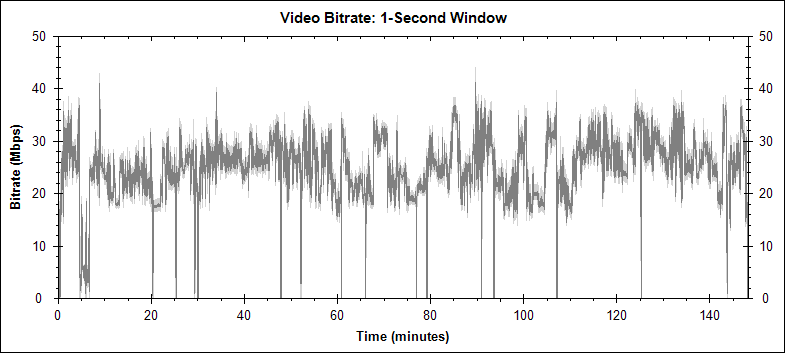
Fact is, the Australian DVD has the worst picture quality of any Australian DVD version of a major movie made in the last twenty years. Part of it was to do with poor picture quality and a poor film print, but the major part was to do with an error made in placing the video on the disc. DVDs store all material in interlaced format, first one field then the other, even though the content may be progressive. The convention is to store the field containing the odd lines first, then the even lines second.
The Pulp Fiction DVD has the fields reversed, as I discuss here. My Australian HI-FI review of the DVD is here.
Taking stills from any frame of this DVD inevitably results in severe combing, for example:
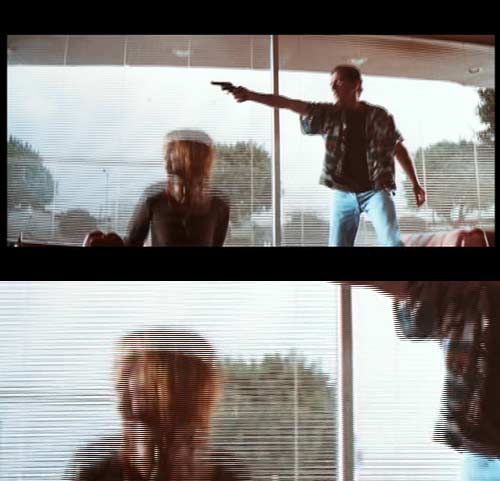
The top is the full frame, while the bottom is a detail, unscaled. You can clearly see the alternating scan lines, one set from one frame, one set from another frame, quite destroying detail.
Over the years I've complained to Roadshow, but nothing seems to have changed on the DVD. In preparing my Blu-ray review, I intended to complain once again about the DVD quality, but I wondered if perhaps they had fixed the problem in a subsequent release, so I hired the '10 Year Anniversay' version. This has clear differences, such as the use of DTS audio. But even though the video was very subtlely different to the earlier version, it still had the mismatched fields and the same general look.
Consequently, fans of the movie purchased an overseas version. I ended up with the UK version (this apparently censored of a few seconds of drug usage). Is the UK version any better? Here's a comparison of the opening frame: a text plate in which there is no movement, and so interlacing shouldn't be a problem. Australian DVD on the left, UK on the right:
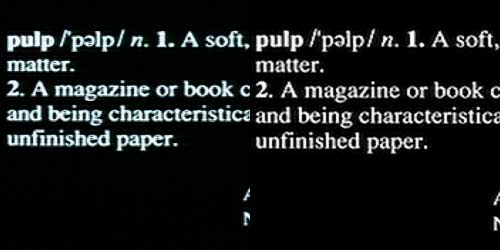
My problem with using the Australian DVD version for comparison was that a good progressive scan DVD player can make the picture look better, much of the time, than I could present in static shots produced using Photoshop. That's because a good progressive scan DVD player would use motion adaptive deinterlacing to preserve full detail on static parts of the picture while eliminating the mismatching scan lines on the moving parts. There are no tools in Photoshop that can accomplish both of those things.
So, in the end, I decided to use the UK version of the DVD for this comparison. Just remember, that as good as the Australian Blu-ray looks compared to the UK DVD, it will look so much better than the Australian DVD. The Blu-ray was supplied by Roadshow Entertainment, as was the original test DVD.
In the following examples, at the top of each is the full frame (suitably shrunk down) used in the comparison, with a 250 pixel wide detail from the frame underneath. The left side is from the UK PAL DVD. The image was captured digitally from the disc (using VideoReDo Plus), scaled by that application from its native 720 by 576 resolution up to 1,024 by 576 (to present in the 16:9 aspect ratio), and then again in Photoshop, in order to be comparable to the Blu-ray version, from that to 1,920 by 1,080. The detail is from that last scaled version, and has not been rescaled again. The right side is from the Australian Blu-ray (captured using the command-line media player Mplayer). This has not been scaled at all.
Since different applications were used to capture the two frames, I am not normally comfortable comparing the brightness or colour between the two. For those visitors from NTSC lands, generally PAL DVDs are just a touch sharper than NTSC DVDs.
The Blu-ray is so much cleaner and more naturalistic:
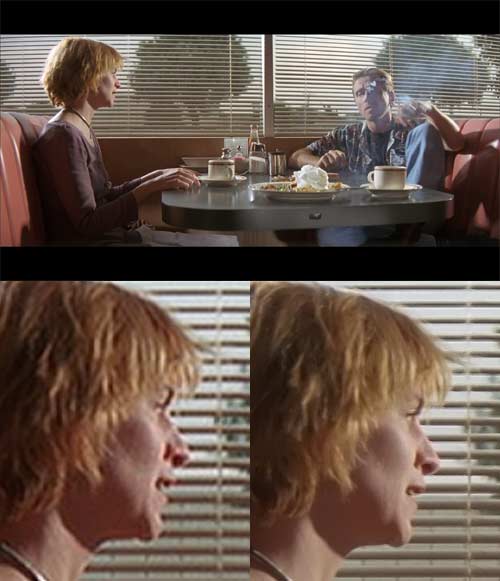
So much so, that I'm choosing another detail from the same scene:
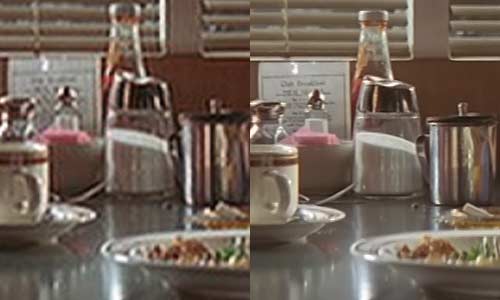
Bit hard to even see where John Travolta is looking in the DVD version of this one:
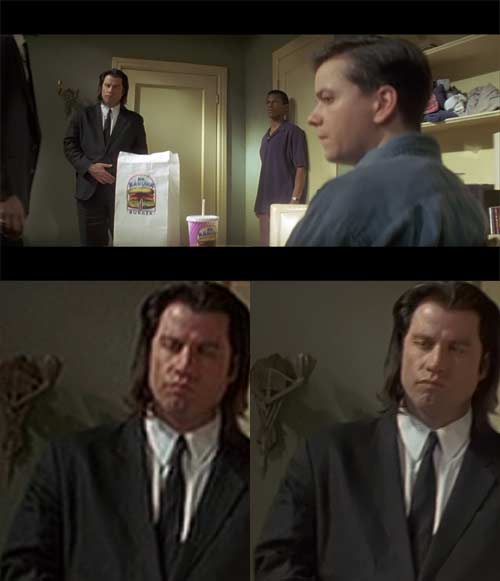
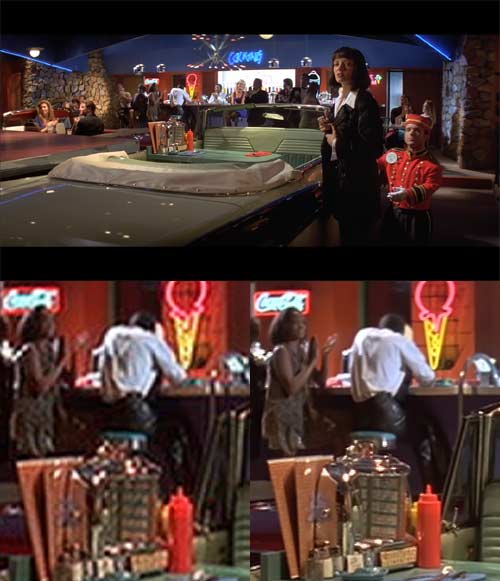
Now, what brand is that VCR? Look to the Blu-ray to find out:
